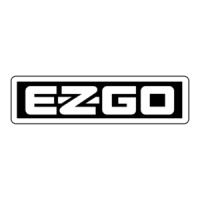FRONT SUSPENSION AND STEERING
Page E-3
Repair and Service Manual
Read all of Section B and this section before attempting any procedure. Pay particular attention to all Notes, Cautions and Warnings
the bearing is removed for inspection. It is recommended
that a bearing packer attached to a grease gun be used;
however, manual packing is acceptable if done correctly.
To pack a bearing manually requires that a dab of grease
be placed in the palm of the hand and the bearing be
dipped in the grease. Force the grease up through and
around all of the rollers until the entire bearing is satu-
rated in grease.
Assemble hub and install on spindle. See ‘Hub Replace-
ment’ on page E-8.
Once hub is placed onto spindle and before
outer wheel bearing is installed, fill the area
between the inner and outer wheel bearings about 1/2 - 3/4 full
with grease.
Wheel Bearing Adjustment
Tool List Qty. Required
Socket, 1 1/2", 1/2" drive............................................. 1
Ratchet, 1/2" drive....................................................... 1
Torque wrench, 1/2" drive, ft. lbs................................. 1
Adapter, 3/8" drive to 1/2" ........................................... 1
Torque wrench, 3/8" drive, in. lbs................................ 1
If performing a wheel bearing adjustment only, lift and
support front of vehicle per SAFETY section. Remove
dust cap (1) and cotter pin (2) and loosen castellated nut
(3).
If performing a wheel bearing adjustment as part of
another procedure, make sure wheel is mounted to hub
hand tight with lug nuts (4) and hub is loosely retained on
spindle (5) with castellated nut (Ref Fig. 3 on page E-3).
Seat bearings by rotating wheel while tightening castel-
lated nut until slight resistance is felt.
Rotate the wheel 2 - 3 more turns to displace excess
grease. If required, tighten castellated nut (3) again until
slight resistance is felt. If the cotter pin hole in the spindle
(5) aligns with a slot in the castellated nut, insert a new
cotter pin (2). If the hole does not align, the castellated
nut must be loosened to align with the closest available
slot in the nut.
Check for smooth and free rotation of the wheel and an
absence of play when the wheel is grasped by the out-
side of the tire. Bend the cotter pin (2) against the flats of
the castellated nut (3).
Replace the dust cap (1) and lower vehicle per SAFETY
section.
If completing a wheel bearing adjustment as part of
another procedure, tighten front wheels per WHEELS
AND TIRES section.
Wheel Alignment
Tool List Qty. Required
Tape measure.............................................................. 1
Chalk ........................................................................... 1
Wrench, 9/16".............................................................. 1
Wrench, 3/4"................................................................ 1
Crowfoot socket, 3/4", 1/2" drive ................................. 1
Torque wrench, 1/2" drive, ft. lbs. ................................ 1
Socket, 13 mm, 3/8" drive ........................................... 1
Ratchet, 3/8" drive....................................................... 1
Torque wrench, 3/8" drive, in. lbs. ............................... 1
Lift the front of the vehicle and support on jack stands as
per SAFETY section. Confirm the alignment of the front
springs. See ‘Front Spring Replacement’ on page E-6.
Rotate each wheel and scribe a chalk line around the cir-
cumference of the tire at the center of the tread pattern.
Lower vehicle and, with tires in the straight ahead posi-
tion, roll it forward approximately five feet in order to
allow the tires to take their normal running position.
Measure the distance between the chalk lines at both the
front and rear of the tires (Ref Fig. 4 on page E-4). The
measurement taken at the front of the tires should be 0" -
1/8" (0 - 3 mm) less than the rear.
Fig. 3 Bearing Adjustment
3
1
2
4
5
Front of Vehicle

